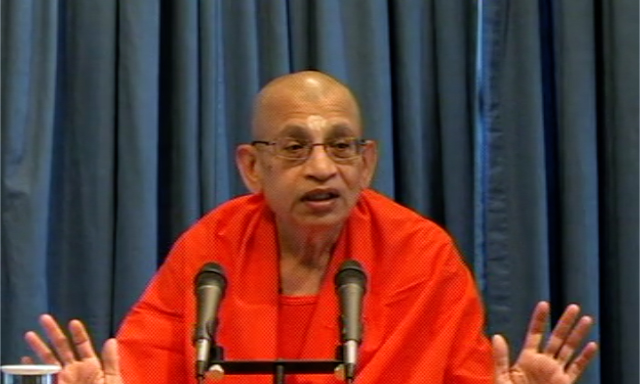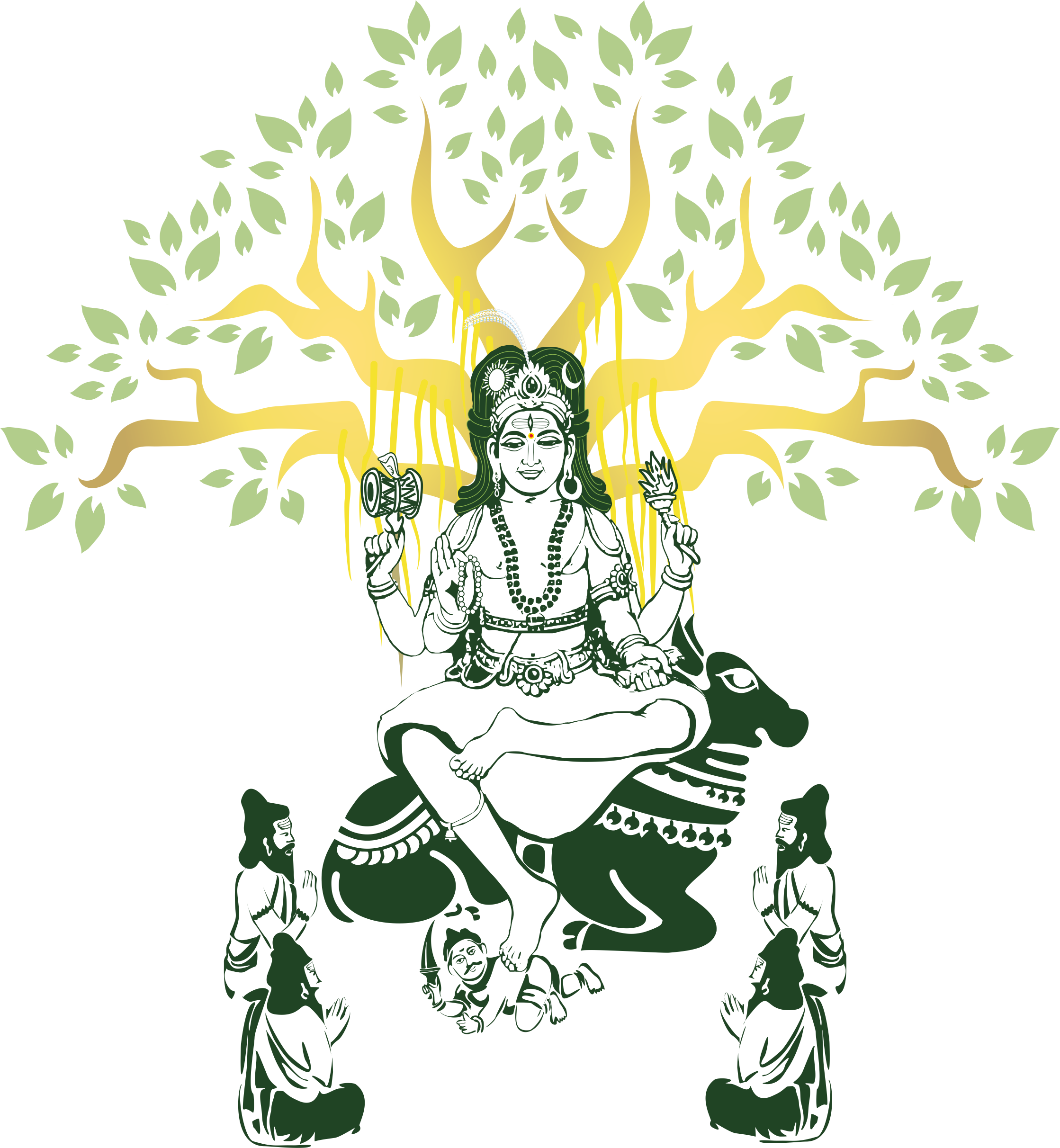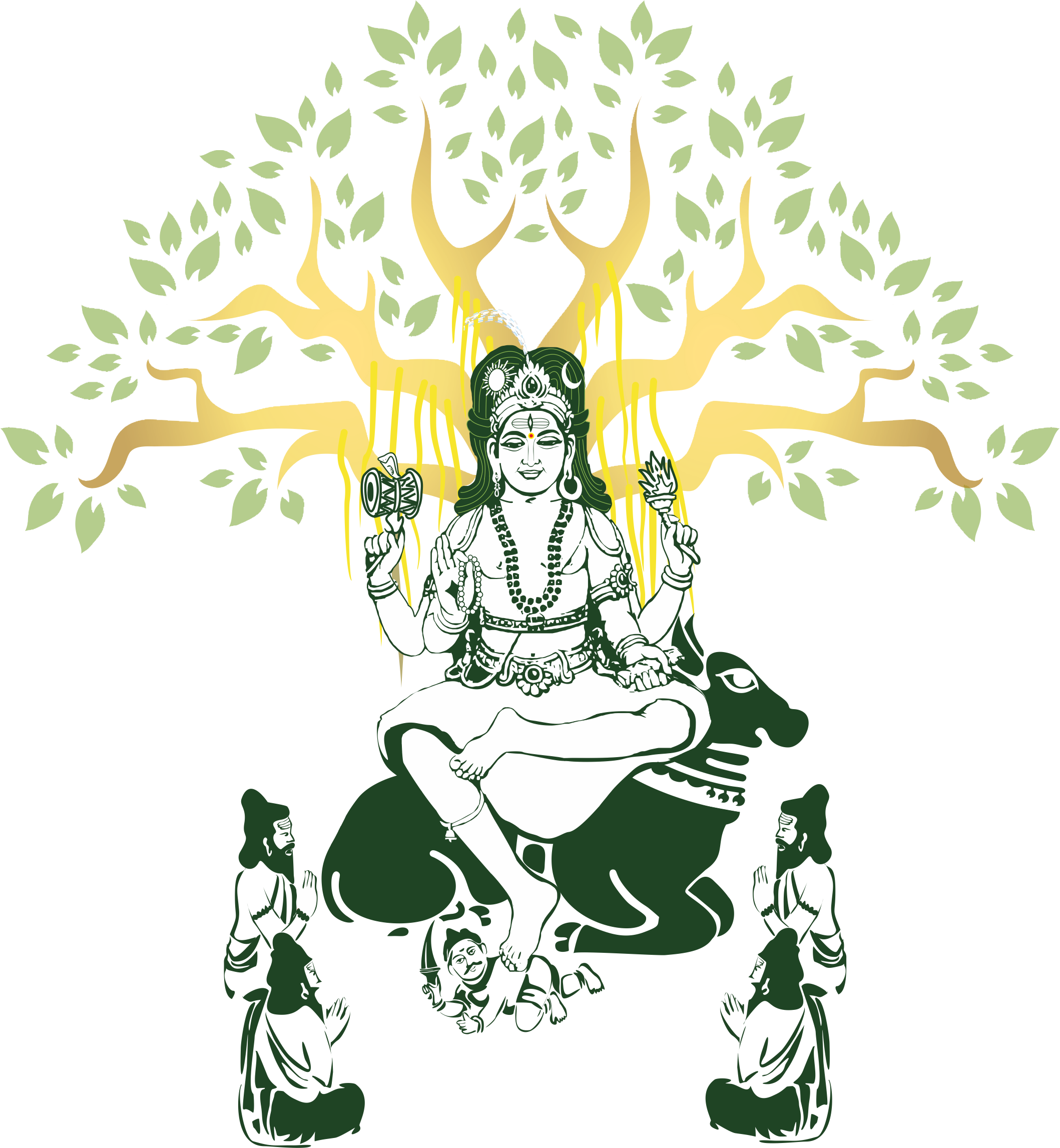Pratah Smaranam (Part-5)
Satsang with Swami Viditatmananda Saraswati
(Continued from previous issue)

The non-Self is able to reveal objects only due to the presence of the Self
Vāco vibhānti nikhilā yadanugraheṇa. Yadanugraheṇa, by whose grace, nikhilā vāco vibhānti, all these words manifest, is speech also manifest. What makes speech function? Again, the Kenopaniṣad [1-5], says,
yadvācā’ nabhyuditaṁ yena vāgabhyudyate,
tadeva brahma tvaṁ viddhi nedaṁ yadidamupāsate.
“Brahman is that very (consciousness) which one does not know with the mind and by which (consciousness), they say, the mind is known” – (Thus) you understand. This (deity), which (people) meditate upon, is not (brahman).
Speech reveals words, and through words, speech reveals various objects and ideas. The Self is that which cannot be revealed by speech, but that because of which speech reveals. It is that which cannot be seen by the eye, but because of which the eyes see. It is that which cannot be thought of by the mind, but because of which the mind thinks. The mind does not have the capacity to think on its own; it is only because of the grace of the consciousness imparted by the Self that the mind is able to think. It is due to grace of the consciousness imparted by the Self that the eyes, ears, and other organs of perception can illumine objects. It is by the grace of the consciousness imparted by the Self that the vital airs function. Therefore, the Self is beyond the reach of the non-Self. The non-Self cannot illumine the Self; in addition, the non-Self is able to reveal the objects only because of the presence of the Self.
Vāco vibhānti nikhilā yadanugraheṇa, by whose grace or in whose presence nikhilā vāca, all this speech, in fact, reveals the objects. That is, in His presence, the mind, organs of perception, and organs of action function, but He is beyond the reach of the mind, organs perception, and organs of action. This is said in order to help us gain the knowledge of the Self. In order to gain knowledge of an object, we use our organs of perception. When we see or hear, we feel or experience, or when we visualize with our minds, we feel we know the object. Thus, our knowledge is through our organs of perception and the mind.
To know a clock, which is in front of me, I require my eyes. The clock does not have the capacity to reveal itself unless my eyes illumine it. The furniture in a dark room does not have the capacity to reveal itself, unless it is illumined by a lamp. It is inert and needs another source to illumine it. So also, the objects of the world are inert and require the organs of perception to illumine them. The organs of perception require the light of the mind, which, in turn, requires the light of Consciousness to illumine them. In Vedantic terminology, all of these are inert, jada; that is, they require the light of Consciousness for their revelation.
But Consciousness itself, being self-effulgent and self illumining, does not require the eyes and ears to illumine it. For example, in a dark room, we require a lamp to illumine the furniture to know that the furniture is; the furniture cannot make itself known. But we don’t need another lamp to know that this lamp is; the lamp reveals itself. Similarly, we require the organs of perception and the mind to know the objects of the world because they cannot reveal themselves
It is necessary to quieten the organs of perception and the mind to recognize the Self even though the Self is self-effulgent
We all shine in the light of Consciousness, but do we need the mind to reveal the Consciousness? No. Consciousness is self-shining. It does not require the mind or the sense organs to reveal it. They shine because of the Consciousness, while Consciousness shines in its own light. It shines and everything shines after it. Therefore, the activity of the organs of perception should be dropped in order to know the Self. Don’t try to ‘perceive’ the Self because it is beyond the organs of perception. Don’t try to see the Self; don’t try to touch the Self; don’t try to smell the Self, and don’t try to taste the Self. We have a tendency to grasp all things through our organs of perception or action; don’t try to do that. Don’t try to visualize with the mind because it is because of ‘that’ that the mind visualizes. When all the attempts on the part of the organs of perception and mind are stopped, we recognize the Self, which always shines. We recognize the Self as the self-shining Consciousness.In fact, It shines even as the mind and the sense organs function. However, because of the clutter of many things in the mind, we do not recognize it. To recognize the Self, it becomes necessary to make our mind and organs of perception quiet. Therefore, we try to make our sense organs quiet in meditation. In meditation, there is nothing to be seen, heard, or touched. You tell the mind also to be quiet, with nothing to be visualized or thought of. Then, what remains is the unadulterated Consciousness, and that is what you are. You are that even when the mind is functioning. It is not that the Consciousness becomes evident only when the mind is not functioning. When the mind is functioning, we confuse the mind with Consciousness. Therefore, it is necessary to quieten the organs of perception and the mind to recognize that Self or the Consciousness is self- shining. Hence, the Self is said to be manasā vacasāmagamyam, that which is beyond the reach of the mind and the sense organs, and moreover, vāco vibhānti nikhilā yadanugrahena, that by whose grace the mind and the sense organs perform their functions. Then, how do the Upanishads teach of this Self?
The Upanishads describe the Self through a process of negation since It is devoid of attributes and limitations
Yaṁ neti neti vacanirnigamā avocuḥ. Nigamā is the Vedas or Upanishads. Avocuḥ means describes. The Upanishads describe the Self in terms of neti neti or not this, not this. The Upanishads describe the Self through the process of negation. That is, what you visualize is not the Self. The one who objectifies is the Self, but not the object that is objectified. All the attributes and qualifications are negated. The self or Consciousness is unqualified. It is free of all attributes and limitations. The ultimate truth or the ultimate reality, which we may call brahman, Self, ātmā, paramātmā, Isvara, Rāma or Krishna, is devoid of all attributes and limitations. An attribute automatically means a limitation; it excludes some other attribute. For example, when we say a particular person is great, the greatness, which is an attribute, implies that he is not little. Or, when we say that a particular flower is red, we mean that it is not green or yellow; it limits the flower to redness and excludes everything else. Any entity that posses an attribute or qualification is limited because it is confined only to that and can be nothing else. But the ultimate truth is that which cannot exclude anything.
Truth is that which includes everything. If God is in heaven, it means that He is not on the earth. Different religious sects describe their gods as being in different heavens. Some say that their god is in Vaikunta, while others say that their god is in a place beyond Vaikunta. Almost everyone, except the Vedāntins, talks about heavens. In India, most people are Dvaitins. The followers of Lord Nārāyana call their heavens Vaikunta; the followers of Lord Siva call it Kailāsa, and the followers of Lord Krishna call it Gokula. That is where their god is and you will go there if you are devoted to that particular god. But the point is that if Lord Krishna is confined to Gokula, he is not here on this earth. However wonderful and divine that god is, as long as he is confined to a place, so long is he not in any other place. That is why we say that nothing can be outside the purview of God; otherwise, God becomes limited. In order for God or Truth to be limitless, It must be all-inclusive. There can be nothing that can be apart from the Truth or God. Even hell cannot be apart from God; neither can evil be independent of It. Therefore, we say that God is apart from both dharma and adharma, virtue and vice. If God is only good, He is not bad; that means there is something that is excluded from God and therefore, God becomes limited. We say God is beyond both good and bad. He includes both and He is, yet, beyond both, just as the actor plays both the beggar as well as the king, while he is himself neither beggar nor king. Therefore, the actor pervades and also transcends both roles. Therefore, the Truth is both immanent as well as transcendent. In these verses, the teacher describes the Truth, which transcends all limitations, attributes, and conditions.
The implied meaning of the words of the scriptures, not their literal meaning describe the Self
A word can only describe that which is limited. Whatever word you use, ātmā or brahman, it really cannot describe brahman because every word describes a certain concept. A word is a sound symbol for describing a concept. When we say ‘clock’, the clock is a concept. Similarly, the word ‘pot’ is a concept. The concept is the form and the word is the name; they are the name and form. All words describe concepts, which are limited. Thus, the words ‘God’, ‘ātmā’, or ‘brahman’ cannot really describe the Self.
What is ātmā? You could say that ātmā is the ‘I’. However, describing it as ‘I’ is also not sufficient because ‘I’ excludes ‘you’. When we say brahman is great, we exclude that which is small. The description of one concept always excludes another concept. Thus, the word ‘God’ cannot describe what we want to describe. Nigamā avocuḥ, the scriptures talk about it. The scriptures say that God is beyond words; yet, the scriptures consist of only words. The Upanishads say that God or brahman is beyond words, and this statement itself is said in words. If words can never describe the Truth or brahman, does it mean that we will never know the Truth? Vedāntins say that the Truth or brahman cannot be the vācyārtha, the literal meaning conveyed by words, but are the lakṣyārtha, the implied meaning of the words.
The words are like the pole used in a pole vault. The pole is used to vault over a high bar, as high as eight or nine feet. One has to necessarily let go of the pole to cross the bar. If one holds on to the pole, one will not be able to cross the bar; on the other hand, if one does not use the pole, one will not be able to rise as high as one needs to. The pole itself is used to transcend the pole. Similarly, in describing brahman words are used to transcend words. If you use the words properly, they will enable you to transcend the words. Therefore, the teachers communicate with us through the words and we have to understand their lakñyārtha, not their vācyārtha.
Neti neti, it is not this, it is not this. What is negated is the vācyārtha, the literal meaning of the words. All the attributes are negated in brahman. The Self or ‘I’ is free from all attributes and qualifications. Everything in this world has qualities. Is it not so? ‘I’, the knower is always different from the known. For example, the knower of a pot is different from the pot. All attributes are known to us. Therefore, ‘I’, the Self must be free of all the attributes because all attributes are known to me.
Pujya Swami Dayanandaji tells this story of a person who once came to him and complained, “I am restless, I am agitated.” Swamiji said, “You are all silence.” “But Swamiji, I tell you I am restless and agitated.” Swamiji told him again that he was all silence. The person got more and more agitated as Swamiji kept telling him that he was all silence. Finally, Swamiji asked him, “How do you know you are agitated?” “I can see that my mind is agitated.” “Okay, your mind may be agitated. Now, you are the knower of the agitation in your mind. The knower is always different from the known. Therefore, as the one who knows of the agitation in your mind, you are indeed free of the agitation. Otherwise, you would not know of the agitation.”
You can know the movement of a train, only when you are standing on a platform that does not move. If you are in a moving train adjacent to another train, which is also moving at the same speed, you will not see the movement of your train. To notice a movement, you have to be free of the movement. To notice an agitation, you should be free from that agitation. To notice a change, you have to be apart from that change. To know an attribute, you have to be free of that attribute. Therefore, who is the Self? Who is the ‘I’? What is Consciousness? It is devoid of all limitations, attributes, qualifications, and conditions. It is the one which illumines all the attributes, conditions, and qualifications.
The scriptures reject the many ideas that arise in our minds: I am tall; neti, you are not. I am fat; neti, you are not. I am short; neti, you are not. I am a woman; neti, you are not. I am a man; neti, you are not. I am good; neti, you are not. I am bad; neti, you are not. I am a doer; neti, you are not. I am a non-doer; neti, you are not.
Each one of these qualifications is negated because each of these ideas arises when we identify with one or the other aspect of our personalities. It is the body or mind, which performs various actions in identification with the ‘I am’. When the body is not acting, I say I am not acting. But the Self is devoid of the idea of acting; acting or not acting belongs only to the non-Self, matter. Not doing anything is also an attribute of the body and the mind. The Self, ‘I’, is beyond the idea of doing and not doing, right and wrong, good and evil, dharma and adharma. The Self, which is beyond all pairs of opposites, is attribute-less. It is self-shining; therefore, you don’t need the sense organs or mind to illumine the Self. It is beyond all limitations, self-existing, self-shining, and because of which everything is illumined. You don’t have to make any effort to reach, know, or experience it. You are That. You don’t have to experience yourself because you are. The question of experiencing comes only when there is something other than you. You cannot be an object of your own experience. You don’t need to experience because you are what you are trying to be. Just be; because that is your nature.
Taṁ devadevamajamacyutamāhuragryam. Deva means god, the shining one. Devadevam is the God of gods, the illuminator of all shining ones. The sun is a deva or devatā. Other devas include the moon, fire etc. Brahman is called devadeva, the one who also illuminates all the devatās, deities. The sun and the moon shine in the light of the Consciousness; they are not self-effulgent. Ajam is birth-less, and acyutam is changeless. Agryam is the foremost, the first one, the one who is the cause the substratum; he is there even when nothing else is.
Transcribed by Richa Choudhry and edited by Krishnakumar (KK) S. Davey and Jayshree Ramakrishnan.
To be Continued



